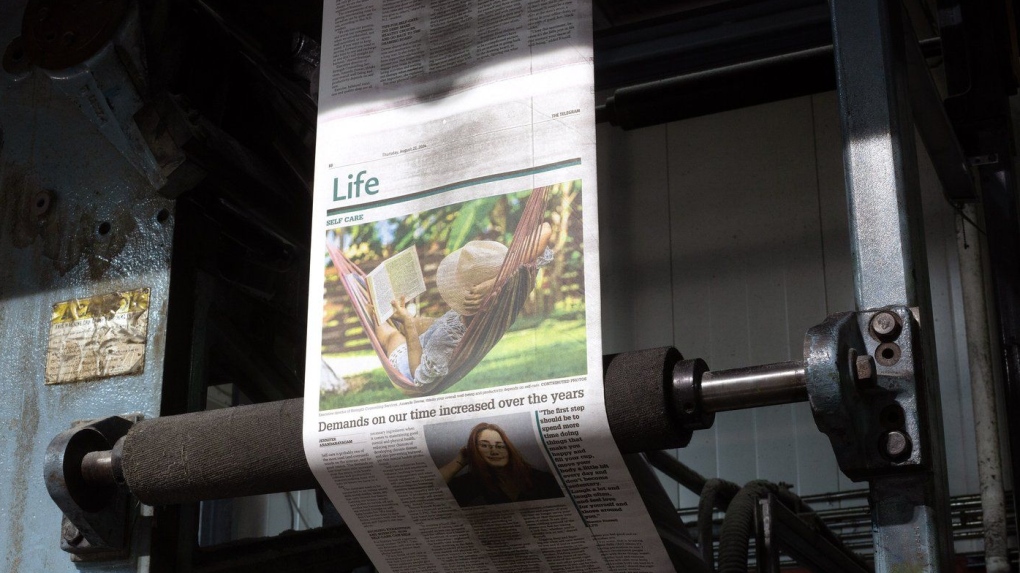Latest News
- Toronto police alert; asking for help identifying suspected child molester
- What you need to know about the oil tanker ban in British Columbia
- Hundreds of homes in northern Ontario mining town left without heat after gas outage
- Quebec judge grants bail to man who spent more than 30 years in prison for four murders
- What do the leaders of Canada's largest white nationalist group want?
Latest Ads
-
Jasmine Jewel
Call
-
Omidan group
Call
-
Amir Madanpour
Call
-
Dimo studio
Call
-
Yorkacademy
Call
-
Maryambagheri
Call
-
Shishlix Restaurant
Call

As Newfoundlanders say goodbye to a daily print paper, some worry culture will suffer
Today is the last day for anyone to pick up Newfoundland and Labrador's main daily paper in print. The St. John's Telegram Press, owned by Saltwire, is shown on Thursday, August 22, 2024.
The final edition of the daily print edition of The Telegram newspaper hit dealers in St. John's, Newfoundland and Labrador on Saturday, marking the end of a 145-year run and a move to a weekly print edition with daily stories online.
People's Paper, as it's also known, was part of Saltwire Networks, which was sold to Postmedia earlier this month in a previously approved deal. The sale did not include the Telegram printing press — the last of its kind in the province — which has left several other newspapers scrambling to find a new program.
On Friday night, the plant went into operation for what could be the last time to print the last daily telegram. The building is on the market for $5.9 million, and if no one comes forward to buy it, it will be gone forever.
People have long turned to printed newspapers to help catalog local life and family stories, said Nicole Penny, with Memorial University's Folklore and Language Archives. The neat and tidy folders of documents that people bring to the archive are always full of Telegram clippings.
He said that these folders and the stories inside them help to outline the social history of the province.
"When someone picks up a newspaper, finds an interesting story, cuts it out, has a connection with family, friends or whatever, and brings it to us. And if it has something to do with Newfoundland and Labrador culture, we'll take it, that's our mission." Penny said in an interview.
"Now the option is to print the story from online and bring it. And, like, how many people have printers at home these days?”
As in the rest of the country, many local and regional newspapers have folded in Newfoundland and Labrador over the past decade. When Saltwire bought the Telegram from Transcontinental Inc. in 2017, it operated about a dozen other newspapers in communities from Happy Valley-Goose Bay, in Labrador, to Port-aux-Basque, a small former fishing town on the southwestern tip of Newfoundland. was doing
According to Saltwire's website, only the Telegram and two free weekly newspapers — the Newfoundland Wire and the Central Wire — were still in circulation as of earlier this week, although the last edition on the site was from December 2023.
With the Telegram moving to a weekly print edition, St. John's, along with Fredericton, are the only provincial capitals to publish an English-language newspaper in print at least five days a week.
Meanwhile, Postmedia's takeover of Saltwire Network has shaken up several independent publications in Newfoundland and Labrador, including the Coastal newspaper. The newspaper served much of southeastern Newfoundland, including many rural communities along the island's east coast, and used the Telegram printing press in St. John's, which Postmedia in Toronto did not buy.
According to a note on the front page of Friday's paper from publisher Craig Westcott, Sahil is now to be printed elsewhere in Canada Atlas.
"We hope this change is temporary," Westcott wrote. "We are working hard to re-establish newspaper printing operations in this province, both to print our own newspapers and to serve other small publishers throughout Newfoundland and Labrador."
Joan Sullivan is also racing to find a new printer for the Newfoundland Quarterly, a 123-year-old arts and culture magazine she edits and runs. He said he was concerned about the significant shipping costs for any publisher to fly or ship their newspapers.
"Those newspapers started for a reason ... people want them," Sullivan said in an interview. "The print remains. People save it, people cherish it, and people read it again."
Sullivan, too, worries about the cultural impact of losing a major daily newspaper in print, but also worries about all the little things produced by the factory in St. John's. He added that these tracts, pamphlets, signs and advertisements all become historical markers and reflect the values and styles of the time in which they were printed.
On Friday night, some Telegram reporters took to social media to share photos of the press working for what was likely to be the final run. Some of the photos showed pages of the final daily print version of the Telegram running through the machines. Others showed factory workers carefully inspecting the print.
The next morning, several people in a St. John's supermarket store had the paper in their shopping carts. Copies were selling out quickly, the cashier confirmed.
A bold headline above China could be read throughout the store: "This is not the end of us."
The first weekly print edition of Telegram is expected to be published on Friday. Daily news continues online.
news source
Suggested Content
Latest Blog
Login first to rate.
Express your opinion
Login first to submit a comment.
No comments yet.


































